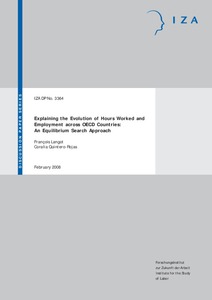Explaining the evolution of hours worked and employment across OECD countries: an equilibrium search approach
"Since 1960, the dynamics of the aggregate hours of market work exhibit dramatic differences across industrialized countries. Before 1980, these differences seem to come from the hours worked per employee (the intensive margin). However, since 1980 a notable feature of the data is that the dive...
| Main Authors: | , |
|---|---|
| Institution: | ETUI-European Trade Union Institute |
| Format: | TEXT |
| Language: | English |
| Published: |
Bonn
2008
IZA |
| Subjects: | |
| Online Access: | https://www.labourline.org/KENTIKA-19189649124919078219-explaining-the-evolution-of-ho.htm |
| Summary: | "Since 1960, the dynamics of the aggregate hours of market work exhibit dramatic differences across industrialized countries. Before 1980, these differences seem to come from the hours worked per employee (the intensive margin). However, since 1980 a notable feature of the data is that the divergence across countries responds to quantitatively important differences along the employment rate (the extensive margin). In this paper we develop an equilibrium matching model where both margins are endogenous. The model is rich enough to account for the behavior of the two margins of the aggregate hours when we include the observed heterogeneity across countries of both the taxes and the labor market institutions such as the unemployment benefits and the bargaining power. Because these findings come from an unified framework, they also give a strong support to the matching models." |
|---|---|
| Physical Description: | 37 p. Digital |

